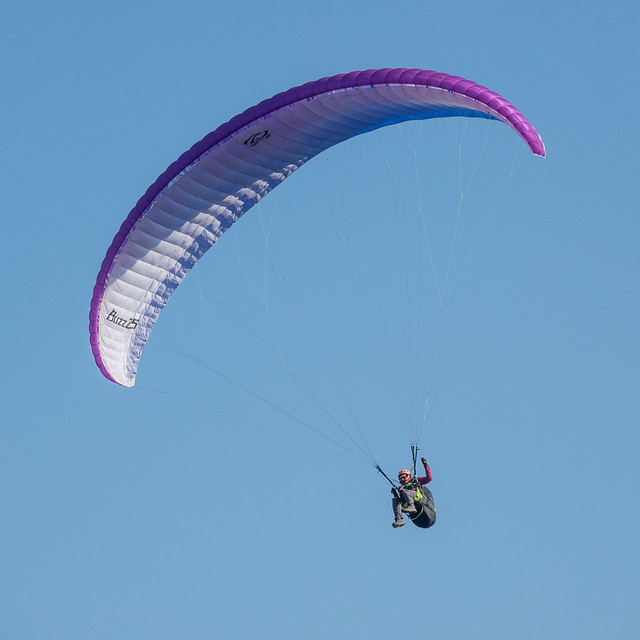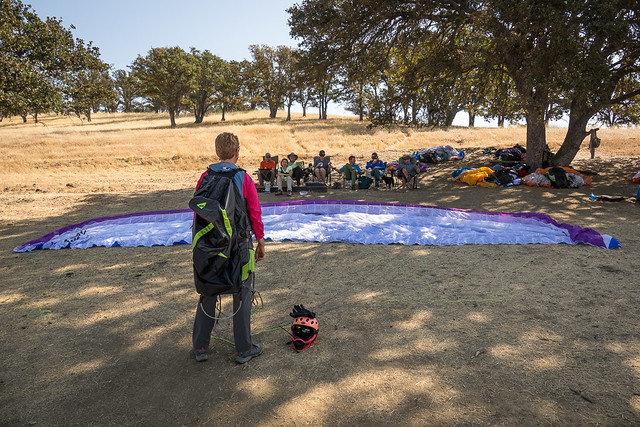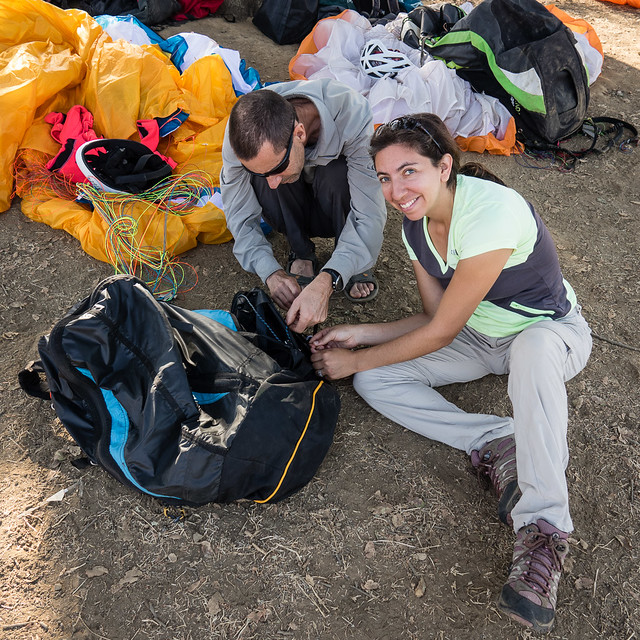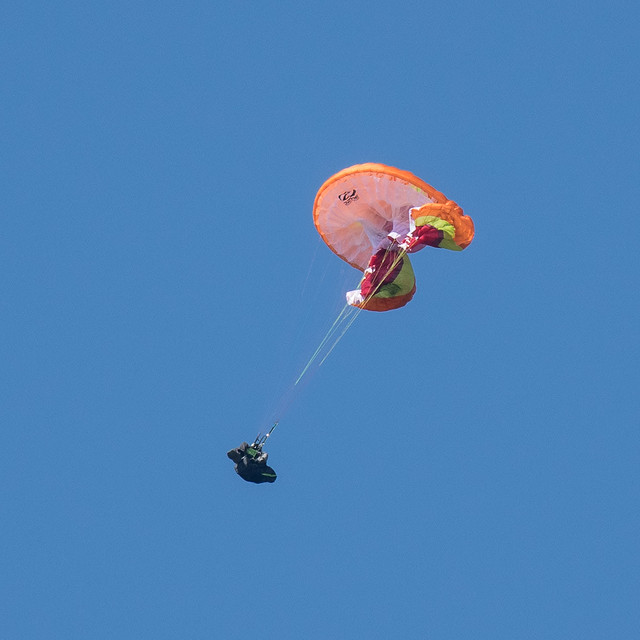Shelley and I just finished a paragliding "SIV" course with Dilan Benedetti of Let Fly Paragliding. SIV stands for "simulation d'incidents en vol" which translates to "simulated incidents in flight". But the only "simulated" part is how they are induced, after that, the incidents are very real.

Some people get a thrill out of swinging, dropping, and spinning. Dilan is a great instructor, but he's also an expert acro (acrobatics) pilot, which means he enjoys doing crazy things with his paraglider (like infinity tumbles). For me these maneuvers are more like taking my medicine - it tastes bad, but I know it's good for me. I'm especially not a fan of spinning - on top of the disorientation, I tend to get motion sickness.

SIV is normally done over water which helps prevent injury if you come down under your reserve parachute. You normally get towed up behind a boat. Thankfully we had previous experience towing, whereas for everyone else it was another new thing to be nervous about. We also had some previous experience with SIV. We had done one day of basic maneuvers as part of a P3 intermediate course, and then Shelley had done an SIV clinic last summer (I just watched since I had broken my thumb.)
We started off with simpler maneuvers - pitch control (like on a swing) and then inducing collapses on one side of the wing (asymmetric) and then on the front of the wing (frontal). Modern paragliders are amazingly well designed. They will happily fly with half the wing disabled and flapping, and recover from collapses quickly and more or less on their own. (At least the safer wings that we have. High end, competitive gliders are not quite so forgiving and require more active control.)

We soon progressed to "autorotations". When you get a collapse on one side of your wing, it has a tendency to rotate. The goal of the exercise is to learn how to safely exit from this. But our wings are specifically designed to not rotate. Even holding a big collapse and throwing my weight onto the collapsed side, I couldn't get my wing to autorotate. I finally had to use my speed bar to make the collapse bigger. As you can imagine, it goes against all your instincts to deliberately do things to overcome and bypass the safety features of your wing. But you can't learn how to "fix" the problems unless you can make them happen.

Once you start rotating you have to be very careful not to release the collapse because the resulting surge as it reinflates can cause you to end up above your wing and then fall through the lines or worst case, fall into the wing itself (which is often game over since it's almost impossible to throw your reserve when you're "gift wrapped"). One of our group failed to hold his collapse and ended up falling through his lines, making the wing unrecoverable. We all listened and watched with wide eyes as Dilan calmly told him to pull his reserve. Thankfully he did and it opened nicely and he landed safely in the water.

Spiral dives are another technique that I'm not fond of. They are an important descent technique but a strong spiral is very unnerving and can be difficult to stop if you get too far in. I have a hard time forcing myself to go into a full spiral and tend to "pop out" because I'm tentative about it (and again, our wings are designed to resist going into a spiral)

One of the big hurdles in SIV is full stalls. Everyone gets nervous about it. I think that's partly because you are taught to never do anything to stall your glider. Going into a stall is easy, you just pull your brakes all the way down below your waist (which you would never do in normal flight). When the wing stalls it goes from a beautiful flying machine to a dishrag flapping in the wind. And since you're hanging from the giant flapping dishrag, you get tossed around (sometimes compared to being in a washing machine). Keeping your legs and arms from flying around is a challenge.

The next trick is coming out of the stall without causing problems. It sounds simple - raise your arms gradually and slowly until the glider starts flying backwards(!) And by the way make sure you keep your brakes symmetrical or you'll start to turn as well. My first stall was far from elegant. Concentrating on my hands, I forgot to hold my legs steady and when they flew around, then I didn't keep my hands steady. But subsequent stalls were easier and better. It's a bizarre feeling to stabilize in "back fly" going in reverse. It's actually quite stable and smooth when you get the brakes in just the right spot. Of course, pull slightly more brake and you're back in the washing machine, or let the brakes go up too much and your wing will try to reinflate and surge forwards. Which is what you do to come out of the back fly, but you have to be prepared to immediately pull the brakes again to "check" the surge. Get that wrong and you're back in risk of falling into your lines or wing. It's not as bad as it sounds, but it's still pretty nerve wracking for us beginners.
Over the three days we got used to following instructions over the radio. Especially when you have a speaker inside your helmet it almost sounds like the voice is inside your head. So I was a bit shocked when Dilan said "ok, now do some more full stalls on your own". It's one thing to have your instructor tell you to do something you really, really don't want to do. It's another thing to initiate it all by yourself. But, as my parents (British) would say "in for a penny, in for a pound". And in the end, you're really doing it yourself regardless.
Overall, it went really well. I wouldn't call it "enjoyable", but a good learning experience. We accomplished what we set out to, which was to learn more about how to handle our wings in a variety of situations.
Of course, being around water, I couldn't resist a few reflection photos.


Some people get a thrill out of swinging, dropping, and spinning. Dilan is a great instructor, but he's also an expert acro (acrobatics) pilot, which means he enjoys doing crazy things with his paraglider (like infinity tumbles). For me these maneuvers are more like taking my medicine - it tastes bad, but I know it's good for me. I'm especially not a fan of spinning - on top of the disorientation, I tend to get motion sickness.

SIV is normally done over water which helps prevent injury if you come down under your reserve parachute. You normally get towed up behind a boat. Thankfully we had previous experience towing, whereas for everyone else it was another new thing to be nervous about. We also had some previous experience with SIV. We had done one day of basic maneuvers as part of a P3 intermediate course, and then Shelley had done an SIV clinic last summer (I just watched since I had broken my thumb.)
We started off with simpler maneuvers - pitch control (like on a swing) and then inducing collapses on one side of the wing (asymmetric) and then on the front of the wing (frontal). Modern paragliders are amazingly well designed. They will happily fly with half the wing disabled and flapping, and recover from collapses quickly and more or less on their own. (At least the safer wings that we have. High end, competitive gliders are not quite so forgiving and require more active control.)

We soon progressed to "autorotations". When you get a collapse on one side of your wing, it has a tendency to rotate. The goal of the exercise is to learn how to safely exit from this. But our wings are specifically designed to not rotate. Even holding a big collapse and throwing my weight onto the collapsed side, I couldn't get my wing to autorotate. I finally had to use my speed bar to make the collapse bigger. As you can imagine, it goes against all your instincts to deliberately do things to overcome and bypass the safety features of your wing. But you can't learn how to "fix" the problems unless you can make them happen.

Once you start rotating you have to be very careful not to release the collapse because the resulting surge as it reinflates can cause you to end up above your wing and then fall through the lines or worst case, fall into the wing itself (which is often game over since it's almost impossible to throw your reserve when you're "gift wrapped"). One of our group failed to hold his collapse and ended up falling through his lines, making the wing unrecoverable. We all listened and watched with wide eyes as Dilan calmly told him to pull his reserve. Thankfully he did and it opened nicely and he landed safely in the water.

Spiral dives are another technique that I'm not fond of. They are an important descent technique but a strong spiral is very unnerving and can be difficult to stop if you get too far in. I have a hard time forcing myself to go into a full spiral and tend to "pop out" because I'm tentative about it (and again, our wings are designed to resist going into a spiral)

One of the big hurdles in SIV is full stalls. Everyone gets nervous about it. I think that's partly because you are taught to never do anything to stall your glider. Going into a stall is easy, you just pull your brakes all the way down below your waist (which you would never do in normal flight). When the wing stalls it goes from a beautiful flying machine to a dishrag flapping in the wind. And since you're hanging from the giant flapping dishrag, you get tossed around (sometimes compared to being in a washing machine). Keeping your legs and arms from flying around is a challenge.

The next trick is coming out of the stall without causing problems. It sounds simple - raise your arms gradually and slowly until the glider starts flying backwards(!) And by the way make sure you keep your brakes symmetrical or you'll start to turn as well. My first stall was far from elegant. Concentrating on my hands, I forgot to hold my legs steady and when they flew around, then I didn't keep my hands steady. But subsequent stalls were easier and better. It's a bizarre feeling to stabilize in "back fly" going in reverse. It's actually quite stable and smooth when you get the brakes in just the right spot. Of course, pull slightly more brake and you're back in the washing machine, or let the brakes go up too much and your wing will try to reinflate and surge forwards. Which is what you do to come out of the back fly, but you have to be prepared to immediately pull the brakes again to "check" the surge. Get that wrong and you're back in risk of falling into your lines or wing. It's not as bad as it sounds, but it's still pretty nerve wracking for us beginners.
Over the three days we got used to following instructions over the radio. Especially when you have a speaker inside your helmet it almost sounds like the voice is inside your head. So I was a bit shocked when Dilan said "ok, now do some more full stalls on your own". It's one thing to have your instructor tell you to do something you really, really don't want to do. It's another thing to initiate it all by yourself. But, as my parents (British) would say "in for a penny, in for a pound". And in the end, you're really doing it yourself regardless.
Overall, it went really well. I wouldn't call it "enjoyable", but a good learning experience. We accomplished what we set out to, which was to learn more about how to handle our wings in a variety of situations.
Of course, being around water, I couldn't resist a few reflection photos.

No comments:
Post a Comment